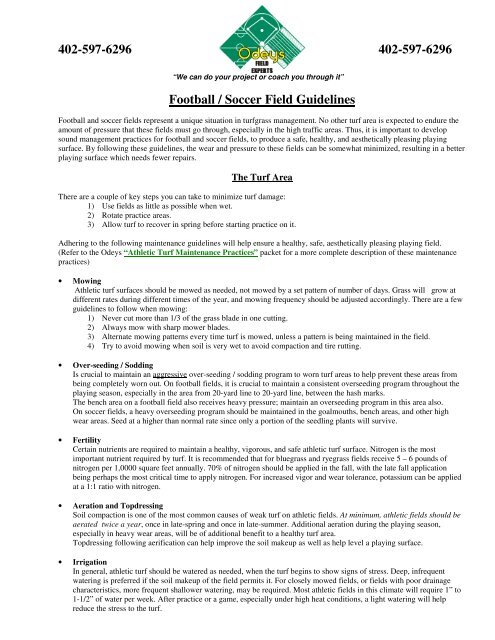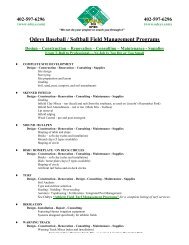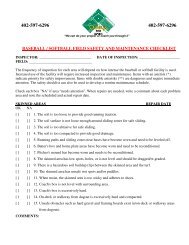Football-Soccer-Fiel..
Football-Soccer-Fiel..
Football-Soccer-Fiel..
You also want an ePaper? Increase the reach of your titles
YUMPU automatically turns print PDFs into web optimized ePapers that Google loves.
402-597-6296 402-597-6296<br />
“We can do your project or coach you through it”<br />
<strong>Football</strong> / <strong>Soccer</strong> <strong>Fiel</strong>d Guidelines<br />
<strong>Football</strong> and soccer fields represent a unique situation in turfgrass management. No other turf area is expected to endure the<br />
amount of pressure that these fields must go through, especially in the high traffic areas. Thus, it is important to develop<br />
sound management practices for football and soccer fields, to produce a safe, healthy, and aesthetically pleasing playing<br />
surface. By following these guidelines, the wear and pressure to these fields can be somewhat minimized, resulting in a better<br />
playing surface which needs fewer repairs.<br />
The Turf Area<br />
There are a couple of key steps you can take to minimize turf damage:<br />
1) Use fields as little as possible when wet.<br />
2) Rotate practice areas.<br />
3) Allow turf to recover in spring before starting practice on it.<br />
Adhering to the following maintenance guidelines will help ensure a healthy, safe, aesthetically pleasing playing field.<br />
(Refer to the Odeys “Athletic Turf Maintenance Practices” packet for a more complete description of these maintenance<br />
practices)<br />
• Mowing<br />
Athletic turf surfaces should be mowed as needed, not mowed by a set pattern of number of days. Grass will grow at<br />
different rates during different times of the year, and mowing frequency should be adjusted accordingly. There are a few<br />
guidelines to follow when mowing:<br />
1) Never cut more than 1/3 of the grass blade in one cutting.<br />
2) Always mow with sharp mower blades.<br />
3) Alternate mowing patterns every time turf is mowed, unless a pattern is being maintained in the field.<br />
4) Try to avoid mowing when soil is very wet to avoid compaction and tire rutting.<br />
• Over-seeding / Sodding<br />
Is crucial to maintain an aggressive over-seeding / sodding program to worn turf areas to help prevent these areas from<br />
being completely worn out. On football fields, it is crucial to maintain a consistent overseeding program throughout the<br />
playing season, especially in the area from 20-yard line to 20-yard line, between the hash marks.<br />
The bench area on a football field also receives heavy pressure; maintain an overseeding program in this area also.<br />
On soccer fields, a heavy overseeding program should be maintained in the goalmouths, bench areas, and other high<br />
wear areas. Seed at a higher than normal rate since only a portion of the seedling plants will survive.<br />
• Fertility<br />
Certain nutrients are required to maintain a healthy, vigorous, and safe athletic turf surface. Nitrogen is the most<br />
important nutrient required by turf. It is recommended that for bluegrass and ryegrass fields receive 5 – 6 pounds of<br />
nitrogen per 1,0000 square feet annually. 70% of nitrogen should be applied in the fall, with the late fall application<br />
being perhaps the most critical time to apply nitrogen. For increased vigor and wear tolerance, potassium can be applied<br />
at a 1:1 ratio with nitrogen.<br />
• Aeration and Topdressing<br />
Soil compaction is one of the most common causes of weak turf on athletic fields. At minimum, athletic fields should be<br />
aerated twice a year, once in late-spring and once in late-summer. Additional aeration during the playing season,<br />
especially in heavy wear areas, will be of additional benefit to a healthy turf area.<br />
Topdressing following aerification can help improve the soil makeup as well as help level a playing surface.<br />
• Irrigation<br />
In general, athletic turf should be watered as needed, when the turf begins to show signs of stress. Deep, infrequent<br />
watering is preferred if the soil makeup of the field permits it. For closely mowed fields, or fields with poor drainage<br />
characteristics, more frequent shallower watering, may be required. Most athletic fields in this climate will require 1” to<br />
1-1/2” of water per week. After practice or a game, especially under high heat conditions, a light watering will help<br />
reduce the stress to the turf.
<strong>Football</strong> / <strong>Soccer</strong> <strong>Fiel</strong>d Guidelines 402-597-6296<br />
The Turf Area (cont.)<br />
• Weed / Insect / Disease Stresses<br />
Is important to continuously monitor stresses placed on the turf by these pests, and take corrective action as needed.<br />
A healthy, vigorous turf can help reduce or overcome damage from these stresses.<br />
General <strong>Fiel</strong>d Guidelines<br />
• Communication<br />
Is crucial that the athletic staff, the grounds staff, and other users of the field communicate frequently.<br />
The athletic staff and other users of the field should communicate field use schedules (games, events, practices, etc.)<br />
as early as possible to the grounds department. Should also keep the grounds department informed as to field<br />
conditions needing attention (too wet, too dry, wet spots, hazardous areas, maintenance issues, damaged equipment<br />
etc.) Is crucial these individuals partner with the grounds staff in maintaining a healthy, safe, and attractive field.<br />
The grounds staff should communicate any changes in field conditions, areas that are under repair and need to be<br />
avoided, applications of fertilizers or pesticides that have been made, when the field is showing signs of overuse and<br />
needs a rest, changes necessary to the field use schedule, and general field conditions.<br />
It is important that all parties associated with the fields use, (athletic directors, coaches, administrators, grounds<br />
personnel, band directors, and players), all work to the common goal of maintaining a safe, healthy, and<br />
aesthetically pleasing athletic playing surface.<br />
• Budgeting<br />
Since there tends to be less money in budgets these days, is crucial to use it wisely. It is important to make a list of<br />
priorities, determine needs, and how to best utilize the budget. Often the least expensive solution is not the one that<br />
provides long- term ongoing benefits, and can end up costing more in the long run.<br />
• Walk the <strong>Fiel</strong>d<br />
This is the single most important step in a maintenance program when it comes to the safety of athletes. Because of this,<br />
it is essential to be aware of such hazards and minimize the risk of injury to players. Know your field, know when there<br />
are changes, and react to those changes immediately.<br />
Walk the field before every practice or game looking for:<br />
1) Sprinkler heads that have not retracted or need to be adjusted.<br />
2) Burrows, large divots, or other holes in turf.<br />
3) Damaged fencing.<br />
4) After rain, mark any areas of standing water with flags, to repair when the field has dried.<br />
5) Check bleachers and player benches for signs of damage.<br />
6) Confirm that goals are secure and properly aligned.<br />
Refer to Odeys “Athletic <strong>Fiel</strong>d Safety Checklist” for a more complete listing. Keep an eye out for these hazards and<br />
help keep young athletes safe.<br />
• Practice Rotation<br />
Rotate practice areas on the field daily so traffic pressure and wear is dispersed across the field.<br />
It is obviously easiest to go to the closest area of the field daily for practice, but is crucial that this pressure is dispersed<br />
over the entire field to reduce wear to any one area. Is much easier and less expensive to repair a stressed area than a<br />
completely worn out area of a field.<br />
• Equipment Removal<br />
Remove all practice equipment (temporary goals, sideline markers, blocking sleds, etc.) from the playing field area daily<br />
so as to not interfere with the irrigation system, to prevent damage to the playing surface from equipment sitting in one<br />
spot, and to help ensure practice equipment gets rotated around the field.<br />
• Waste<br />
Discard all trash into waste receptacles and ensure that adequate receptacles are available and emptied regularly.<br />
• Involvement<br />
A key to success is getting others involved in maintaining the field. Assign players certain responsibilities (moving<br />
practice equipment, picking up trash) that they must accomplish everyday. Give parents incentives to participate in the<br />
field’s maintenance. Be creative. The more people involved, the more work will get done to the field.<br />
Remember, “The field you put to bed in the fall, is the field you will wake up to in the spring”.





